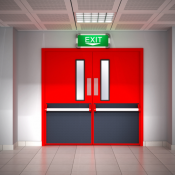
What Is a Fire Risk Assessment?
A fire risk assessment is a structured review of a building or premises to identify potential fire hazards, determine who may be at risk, and evaluate whether adequate fire prevention and emergency measures are in place. It is a legal requirement under the Regulatory Reform (Fire Safety) Order 2005 for most non-domestic premises in the UK.
Whether you manage a small retail unit, an office block, a care home, or a residential property with communal areas, a fire risk assessment is critical to protecting people and ensuring compliance with the law.
What Does a Fire Risk Assessment Involve?
The process is essentially a form of general risk assessment focused specifically on fire safety. It typically includes:
1. Identifying Fire Hazards
This is based on the fire triangle and the three elements required for a fire to occur:
- Sources of ignition: These include electrical equipment (most common), cooking appliances in kitchens, open flames, heaters, and arson.
- Sources of fuel: Paper, cardboard, rubbish in bins, poor housekeeping, textiles, packaging materials, and flammable liquids.
- Sources of oxygen: Normally just air, but can include oxygen cylinders, mechanical ventilation, or poorly managed airflow.
2. Identifying People at Risk
This includes:
- Staff who are familiar with procedures and exits
- Visitors or contractors who may not know how to escape
- Vulnerable individuals, such as elderly residents, children, or those with disabilities
Where appropriate, the responsible person must put in place:
- PEEPs (Personal Emergency Evacuation Plans)
- GEEPs (General Emergency Evacuation Plans)
3. Evaluating Risk and Deciding Precautions
This means assessing how likely a fire is to start and whether your current systems are enough to protect life and property. Common precautions include:
- Fire alarms, emergency lighting, and signage
- Escape route design and clarity
- Fire doors and compartmentation
- Extinguishers and suppression systems
- Regular fire drills and training
4. Recording Findings and Creating an Action Plan
A written record is legally required if you have five or more employees.
- Simple premises can use Home Office templates
- Complex buildings may require more formal methods like PAS 79
- Newer guidance is also available under BS 9792, which supersedes PAS 79 in many settings and outlines a complete fire risk management system
5. Reviewing and Updating the Assessment
Contrary to popular belief, there is no requirement to review annually. Instead, the assessment should be reviewed when:
- There are significant changes to the building or its use
- Occupancy or risk levels change
- New fire safety regulations are introduced
Automatic annual reviews are common practice but not a legal requirement unless changes occur.
Who Needs a Fire Risk Assessment?
Under Article 3 of the Fire Safety Order, the duty lies with the “responsible person,” which may be:
- Employers
- Building owners
- Landlords
- Facilities managers
- Heads of departments or estate managers in public sector buildings
In multi-tenanted buildings, there may be multiple duty holders. In such cases, Article 22 requires them to cooperate and communicate to ensure collective compliance.
Can I Do It Myself or Do I Need a Professional?
Technically, a responsible person can complete the assessment if they are competent but that’s a high bar to meet. Competence means:
- Understanding the relevant legislation
- Knowing how fires start and spread
- Being able to evaluate complex risks and building layouts
In practice:
- Low-risk buildings (e.g. small offices) might use templates
- Most businesses benefit from hiring a qualified and insured consultant
- Complex or high-risk premises should always use a professional
How Much Does It Cost?
Pricing varies depending on the size, complexity, and type of building:
| Type of Premises | Typical Cost Range |
|---|---|
| Small shop or office | £350 – £500 |
| Multi-use commercial building | £600 – £1,200+ |
| Care homes, hospitals, large hotels | Bespoke – often higher |
Need Help Finding a Fire Risk Assessor?
We can connect you with a verified, insured fire safety consultant in your area. Whether you’re preparing for an inspection, managing multiple properties, or updating outdated documentation — we’re here to help.



